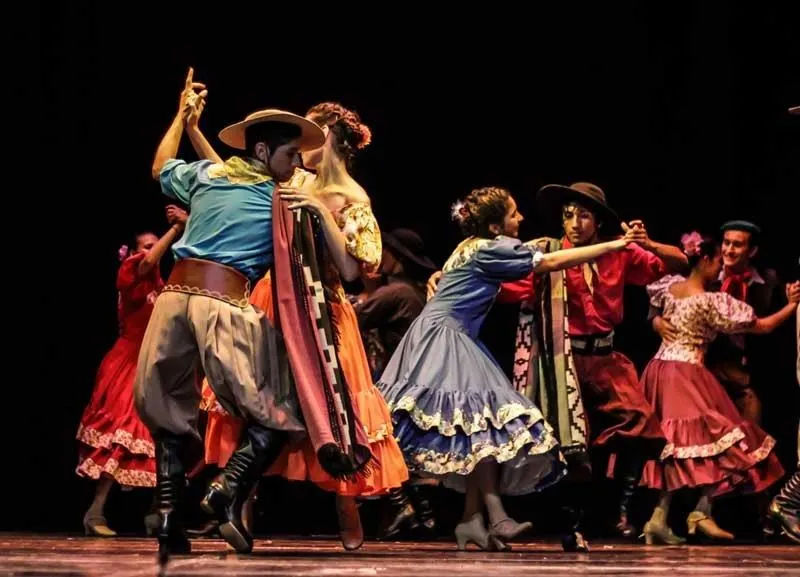When we were kids, my dad used to make us listen to Argentine folklore. We listened, almost exclusively, to Los Chalchaleros. It’s not that he forced us, not at all, but the music played when we traveled by car to Villa Carlos Paz, Colón, Mendoza. And back then there were no headphones, no smartphones, and if there had been, they wouldn’t have been available to us anyway. So we had to listen. This continuous exposure for several hours locked in a car, and then occasionally at home (where at least there was a chance to escape), can have different effects on different people. For example, my younger sister hates folklore. My middle sister doesn’t care about it. I like it. I won’t say I’m crazy about it, but I like it a lot, and I think I’ve learned to appreciate it. And being away from one’s homeland, folklore has a nostalgic effect to which I’m very prone.
Folk music talks about the most typical themes (like love), but especially about places: a town, a river, even a particular street, different from all other streets, like the song “Calle angosta” (“Narrow street”):
Narrow street, narrow street
The one with only one sidewalk
I sing to you because you will always
be in my memory
You’re the humblest street
of my town of Mercedes
You begin at the poplars
and end at the mill
… and when listening to it, this translates to my town, Avellaneda (Santa Fe), on Route 11, to my street: 16th Street which, neither short nor narrow, begins at the railroad tracks and crosses the entire city, passing by where childhood friends lived, cousins, where we took the TV or radio to be repaired, where we played soccer with two trees as goal posts and once a ball broke a neighbor’s light bulb, where I once blushed to walk past. The street that led me to my friend’s house and where my elementary and high school was (and still is).
And now, like dad about 25 years ago, I find myself, too, listening to folklore with my two children. The other day we were coming back with Guadalupe from kindergarten in the car (yes, where she can’t escape) listening to “Santafecino de veras,” (“True Santafecino,” meaning a genuine person from Santa Fe) a song popularized mainly by Jorge Cafrune, written by Miguel Brascó and Ariel Ramirez. The version I like, of course, is performed by Los Chalchaleros (with the presence of Ariel Ramirez), and it ends like this:
If I die, it will be singing
my love for my Santa Fe
Death will have to take me
singing this chamamé
Because I’m from Santa Fe
which is the place where I was born
… where a physical place, Santa Fe, which is the place where I was born (“the place where I was born,” I thought, what a mystery), mixes with my death and the meaning of my life. Like when José de San Martín, an Argentine hero who, with others, led the liberation of much of South America from the Spanish Empire, writes to Tomás Guido in 1827, from Paris, France, already retired from his military career, and tells him:
My dear friend:
Today I will tell you something about myself. Although it may seem strange to you, lately I don’t see or deal with any living person, because as a result of the wars I have taken a certain distance from men. I live in a small country house, three blocks from the city, in the company of my brother. I spend my mornings working in my garden and in my carpentry workshop; in the afternoons, I go for walks, and at night I read and reread cheerful books; here is my simple life.
You will ask if I am happy. Yes, friend, I truly am but believe me that there is still a hole in my happiness, and do you know what it is?: not being able to be in Mendoza. You will laugh at this, do so if you want, but I assure you that I prefer the life I had on my farm to the advantages that the cultured life of Europe presents. I wish to spend my last days there, and truly I ask for nothing else in consideration of the services I believe I have rendered to my beloved America.
Your friend and confidant.
José de San Martín
I wonder if that hole would have been filled for San Martín if he had been able to return to his beloved farm in Mendoza. Although I’ve been living eight years away from my places, I have the possibility of returning every year and visiting my cities, my street, which means bringing back the past, the memories, and connecting them with the present, with my family and loved ones. And while the joy of the encounter is sweet, experience also tells me that this “place,” when it becomes close, then transfigures itself, and becomes remote once again. As if the heart had been confused, and when it reaches what it thought was the goal, it finds itself again as in the beginning with the longing for a place, another one, that wasn’t this one.
But returning to these places is, at least for me, part of the journey, like a mandatory stop that helps remember that, if we desire it so much, perhaps there is a goal, a definitive place. When we speak of “folklore,” we speak of “tradition,” which, as Luigi Giussani said, “is that complex endowment with which nature arms us… an instrument with which we can confront our surroundings.” And this precious folkloric tradition, which connects past and present with music, places and people, my existence and its meaning, provides me with indispensable elements to develop a broader view of life.
